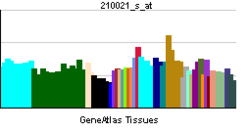- Cyclin O
-
Cyclin O Identifiers Symbols CCNO; CCNU; FLJ22422; UDG2; UNG2 External IDs OMIM: 607752 MGI: 2145534 HomoloGene: 50171 GeneCards: CCNO Gene Gene Ontology Molecular function • uracil DNA N-glycosylase activity
• uracil DNA N-glycosylase activity
• protein kinase bindingCellular component • nucleus
• nucleoplasm
• nucleoplasm
• nucleoplasmBiological process • regulation of cyclin-dependent protein kinase activity
• DNA repair
• base-excision repair
• base-excision repair
• base-excision repair, AP site formation
• depyrimidination
• cell divisionSources: Amigo / QuickGO RNA expression pattern 
More reference expression data Orthologs Species Human Mouse Entrez 10309 218630 Ensembl ENSG00000152669 ENSMUSG00000042417 UniProt P22674 P0C242 RefSeq (mRNA) NM_001024592 NM_001081062.1 RefSeq (protein) NP_001019763 NP_001074531.1 Location (UCSC) Chr 5:
54.53 – 54.53 MbChr 13:
113.78 – 113.78 MbPubMed search [1] [2] Cyclin-O is a protein that in humans is encoded by the CCNO gene.[1]
Interactions
Cyclin O has been shown to interact with RPA2[2] and PCNA.[2][3]
References
- ^ "Entrez Gene: CCNO cyclin O". http://www.ncbi.nlm.nih.gov/sites/entrez?Db=gene&Cmd=ShowDetailView&TermToSearch=10309.
- ^ a b Otterlei, M; Warbrick E, Nagelhus T A, Haug T, Slupphaug G, Akbari M, Aas P A, Steinsbekk K, Bakke O, Krokan H E (Jul. 1999). "Post-replicative base excision repair in replication foci". EMBO J. (ENGLAND) 18 (13): 3834–44. doi:10.1093/emboj/18.13.3834. ISSN 0261-4189. PMC 1171460. PMID 10393198. http://www.pubmedcentral.nih.gov/articlerender.fcgi?tool=pmcentrez&artid=1171460.
- ^ Ohta, Satoshi; Shiomi Yasushi, Sugimoto Katsunori, Obuse Chikashi, Tsurimoto Toshiki (Oct. 2002). "A proteomics approach to identify proliferating cell nuclear antigen (PCNA)-binding proteins in human cell lysates. Identification of the human CHL12/RFCs2-5 complex as a novel PCNA-binding protein". J. Biol. Chem. (United States) 277 (43): 40362–7. doi:10.1074/jbc.M206194200. ISSN 0021-9258. PMID 12171929.
Further reading
- Caradonna S, Muller-Weeks S (2002). "The nature of enzymes involved in uracil-DNA repair: isoform characteristics of proteins responsible for nuclear and mitochondrial genomic integrity". Curr. Protein Pept. Sci. 2 (4): 335–47. doi:10.2174/1389203013381044. PMID 12369930.
- Muller SJ, Caradonna S (1991). "Isolation and characterization of a human cDNA encoding uracil-DNA glycosylase". Biochim. Biophys. Acta 1088 (2): 197–207. PMID 2001396.
- Muller SJ, Caradonna S (1993). "Cell cycle regulation of a human cyclin-like gene encoding uracil-DNA glycosylase". J. Biol. Chem. 268 (2): 1310–9. PMID 8419333.
- Otterlei M, Warbrick E, Nagelhus TA et al. (1999). "Post-replicative base excision repair in replication foci". EMBO J. 18 (13): 3834–44. doi:10.1093/emboj/18.13.3834. PMC 1171460. PMID 10393198. http://www.pubmedcentral.nih.gov/articlerender.fcgi?tool=pmcentrez&artid=1171460.
- Mer G, Bochkarev A, Gupta R et al. (2000). "Structural basis for the recognition of DNA repair proteins UNG2, XPA, and RAD52 by replication factor RPA". Cell 103 (3): 449–56. doi:10.1016/S0092-8674(00)00136-7. PMID 11081631.
- Kavli B, Sundheim O, Akbari M et al. (2002). "hUNG2 is the major repair enzyme for removal of uracil from U:A matches, U:G mismatches, and U in single-stranded DNA, with hSMUG1 as a broad specificity backup". J. Biol. Chem. 277 (42): 39926–36. doi:10.1074/jbc.M207107200. PMID 12161446.
- Ohta S, Shiomi Y, Sugimoto K et al. (2002). "A proteomics approach to identify proliferating cell nuclear antigen (PCNA)-binding proteins in human cell lysates. Identification of the human CHL12/RFCs2-5 complex as a novel PCNA-binding protein". J. Biol. Chem. 277 (43): 40362–7. doi:10.1074/jbc.M206194200. PMID 12171929.
- Strausberg RL, Feingold EA, Grouse LH et al. (2003). "Generation and initial analysis of more than 15,000 full-length human and mouse cDNA sequences". Proc. Natl. Acad. Sci. U.S.A. 99 (26): 16899–903. doi:10.1073/pnas.242603899. PMC 139241. PMID 12477932. http://www.pubmedcentral.nih.gov/articlerender.fcgi?tool=pmcentrez&artid=139241.
- Priet S, Navarro JM, Gros N et al. (2003). "Differential incorporation of uracil DNA glycosylase UNG2 into HIV-1, HIV-2, and SIV(MAC) viral particles". Virology 307 (2): 283–9. doi:10.1016/S0042-6822(02)00073-9. PMID 12667798.
- Elder RT, Zhu X, Priet S et al. (2003). "A fission yeast homologue of the human uracil-DNA-glycosylase and their roles in causing DNA damage after overexpression". Biochem. Biophys. Res. Commun. 306 (3): 693–700. doi:10.1016/S0006-291X(03)01036-2. PMID 12810074.
- Ota T, Suzuki Y, Nishikawa T et al. (2004). "Complete sequencing and characterization of 21,243 full-length human cDNAs". Nat. Genet. 36 (1): 40–5. doi:10.1038/ng1285. PMID 14702039.
- Lu X, Bocangel D, Nannenga B et al. (2004). "The p53-induced oncogenic phosphatase PPM1D interacts with uracil DNA glycosylase and suppresses base excision repair". Mol. Cell 15 (4): 621–34. doi:10.1016/j.molcel.2004.08.007. PMID 15327777.
- Schmutz J, Martin J, Terry A et al. (2004). "The DNA sequence and comparative analysis of human chromosome 5". Nature 431 (7006): 268–74. doi:10.1038/nature02919. PMID 15372022.
- Gerhard DS, Wagner L, Feingold EA et al. (2004). "The Status, Quality, and Expansion of the NIH Full-Length cDNA Project: The Mammalian Gene Collection (MGC)". Genome Res. 14 (10B): 2121–7. doi:10.1101/gr.2596504. PMC 528928. PMID 15489334. http://www.pubmedcentral.nih.gov/articlerender.fcgi?tool=pmcentrez&artid=528928.
- Hirst R, Gosden R, Miller D (2006). "The cyclin-like uracil DNA glycosylase (UDG) of murine oocytes and its relationship to human and chimpanzee homologues". Gene 375: 95–102. doi:10.1016/j.gene.2006.02.030. PMID 16697536.
- Verma SC, Bajaj BG, Cai Q et al. (2006). "Latency-Associated Nuclear Antigen of Kaposi's Sarcoma-Associated Herpesvirus Recruits Uracil DNA Glycosylase 2 at the Terminal Repeats and Is Important for Latent Persistence of the Virus". J. Virol. 80 (22): 11178–90. doi:10.1128/JVI.01334-06. PMC 1642147. PMID 16928741. http://www.pubmedcentral.nih.gov/articlerender.fcgi?tool=pmcentrez&artid=1642147.
- Yang B, Chen K, Zhang C et al. (2007). "Virion-associated uracil DNA glycosylase-2 and apurinic/apyrimidinic endonuclease are involved in the degradation of APOBEC3G-edited nascent HIV-1 DNA". J. Biol. Chem. 282 (16): 11667–75. doi:10.1074/jbc.M606864200. PMID 17272283.
- felbauer B, Hakata Y, Schrö Landau NR (2007). "HIV-1 Vpr function is mediated by interaction with the damage-specific DNA-binding protein DDB1". Proc. Natl. Acad. Sci. U.S.A. 104 (10): 4130–5. doi:10.1073/pnas.0610167104. PMC 1820720. PMID 17360488. http://www.pubmedcentral.nih.gov/articlerender.fcgi?tool=pmcentrez&artid=1820720.
- Pettersen HS, Sundheim O, Gilljam KM et al. (2007). "Uracil–DNA glycosylases SMUG1 and UNG2 coordinate the initial steps of base excision repair by distinct mechanisms". Nucleic Acids Res. 35 (12): 3879–92. doi:10.1093/nar/gkm372. PMC 1919486. PMID 17537817. http://www.pubmedcentral.nih.gov/articlerender.fcgi?tool=pmcentrez&artid=1919486.
Categories:- Human proteins
- Chromosome 5 gene stubs
Wikimedia Foundation. 2010.
